Guide to Purchasing COB LED Strips: Must-Know Facts
Table of Contents
COB (Chip-on-Board) LED strips have quickly become a popular choice for modern lighting solutions, thanks to their seamless light output, high efficiency, and compact design. Whether you’re upgrading your home lighting, working on a commercial project, or diving into DIY setups, understanding what to look for when purchasing COB LED strips is essential.
This guide covers the key facts you need to know—from performance benefits to technical specifications—so you can make a confident and informed buying decision.

What is COB?
In the realm of LED technology, COB refers to Chip on Board. This means the LED chip is directly integrated onto the circuit board, also known as PCB. Flexible strip lights with “Chip on Board” LEDs are sometimes called flip-chips.
In essence, flip-chip LEDs represent a minimalistic approach to LED design. To illustrate, consider a typical SMD (Surface Mount Device) LED, which features a lamp bead holder that packages the LED chip and then applies a phosphor coating layer. The ‘flip-chip’ design of the COB LED strip strips away all but the LED chip, yellow phosphor cover layer, and connecting pads.
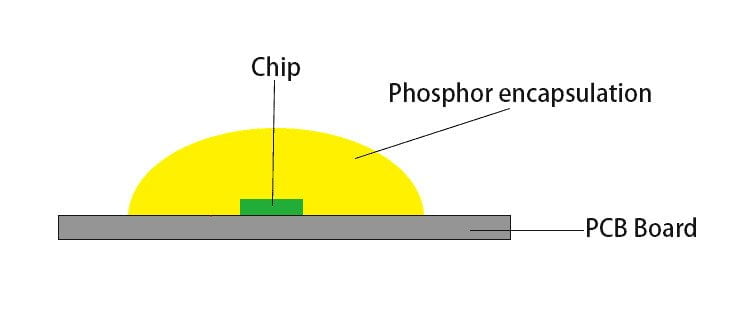
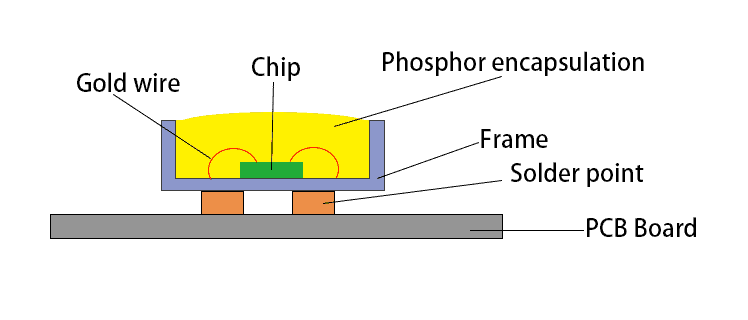
So, what exactly is a COB LED strip light?
A COB LED strip light or tape light involves LED chips directly mounted onto the FPCB (Flexible Printed Circuit Board). It results in a seamless, dot less LED strip light, which is why COB LED strip light is also known as continuous or dot less.
How do COB and SMD LED strips compare?
- Unlike the 120-degree beam angle of SMD LED strips, COB LED strips have a 180-degree beam angle.
- COB LED strips offer superior flexibility compared to SMD LED strips.
- COB LED strips to provide uniform, dot less light.
- COB, or chip on board, LED strips lack gold wiring, which is present in SMD LED strips.
How is the COB LED flexible strip produced?
- Initial Chip Expansion
- Die Bonding
- Placement of Resistors onto FPCB
- Reflow- Heating above 65 degrees for the final PCB with chips and resistors
- Mixing of Fluorescent Powder Glue
- Application of the mixed glue onto the surface of chips and resistors using an automatic glue machine
- Placement of glued COB LED strip into an oven
- Quality Control – testing the COB LED strip post-cooling
- Soldering the PCB into 5-meter reels or lengths as per customer requirement
- Aging test, further Quality Control, packaging, and then shipping.
Pros and Cons of COB LED Flex Strips
Having gained a fundamental grasp of the production process of the innovative COB LED strip, let’s explore its benefits and drawbacks.
Pros:
One of the primary issues with conventional LED strips is a “lighting dot” – a bright spot on the strip where the light source is visible. This phenomenon disrupts the continuity of light, creating an uneven look. A smooth and unified light source is generally more visually appealing than a strip dotted with bright spots.
In the 5050 SMD flex strips, the sizeable diodes are arranged closely to ensure a balanced light distribution over the surface when viewed from a distance. However, when the light is too close to the surface of the strip is exposed, the bright spots become an unavoidable distraction to the human eye.
With a 480 chip/M COB strip, spotting any bright spots on the flex strip becomes nearly impossible. This strip provides a soft, consistent light across its entire length. Its absence of bright spots makes the light more visually pleasing and allows it to maintain steady Lighting even in narrow areas. The only way to discern the individual lighting dot is by inspecting the back of the strip, where the individually positioned flip-chip LEDs are more noticeable. Only the individual led can be seen when the strip’s brightness is dimmed to around 5%. This quality makes COB flex strips an ideal choice for applications where:
- The LED strip cannot be concealed.
- The surface to be lit is within 2 feet of the light bar.
- Reflective surfaces like granite or glass are prevalent.
- A robust neon effect is desired.
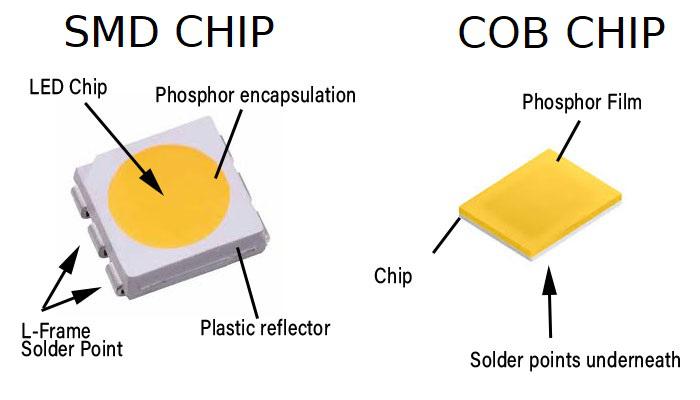
Enhanced flexibility
These strips offer greater flexibility than other strips due to the small diodes and their evenly distributed weight. The diodes are so minute and densely packed that the strip has no unevenness. This consistency makes the strip installation easier as you no longer need to work around a protruding 5050 SMD LED. This added flexibility facilitates installation in cramped spaces and around corners.
Increased stability, reduced complications
- The chip in a COB strip is attached directly to the FPCB without needing gold wire. A common issue with traditional SMD LED strips is the breakage of the gold wire inside the LED beads, which often results in non-illuminated chips.
- The circuit design of the COB strip incorporates three chips, initially arranged in parallel as a group; then, each group is arranged in series to form a single strip. This design ensures that the strip emits light even if a couple of chips within a group malfunction. On a COB strip with 480 chips per meter, the non-functioning of 1-2 chips won’t create dark patches or hinder the strip’s functionality. In contrast, a single malfunctioning bead can render an entire section non-illuminated with traditional SMD strips, creating noticeable dark spots.
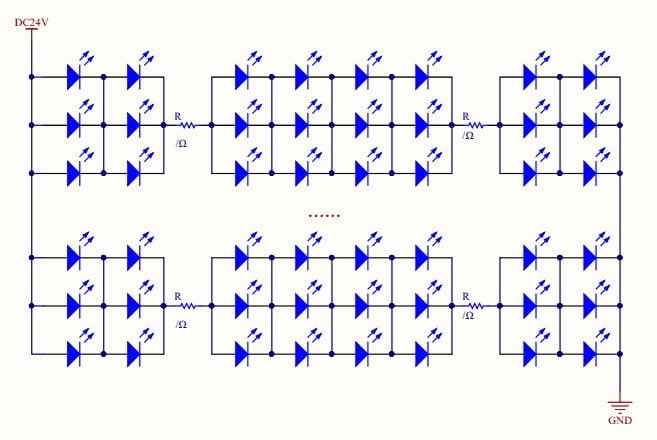
Expansive Light Dispersion
Typical Surface Mount Device (SMD) light strips have a luminous angle of 120 degrees, whereas the Chip On Board (COB) light strips boast an impressive luminous angle of 180 degrees.
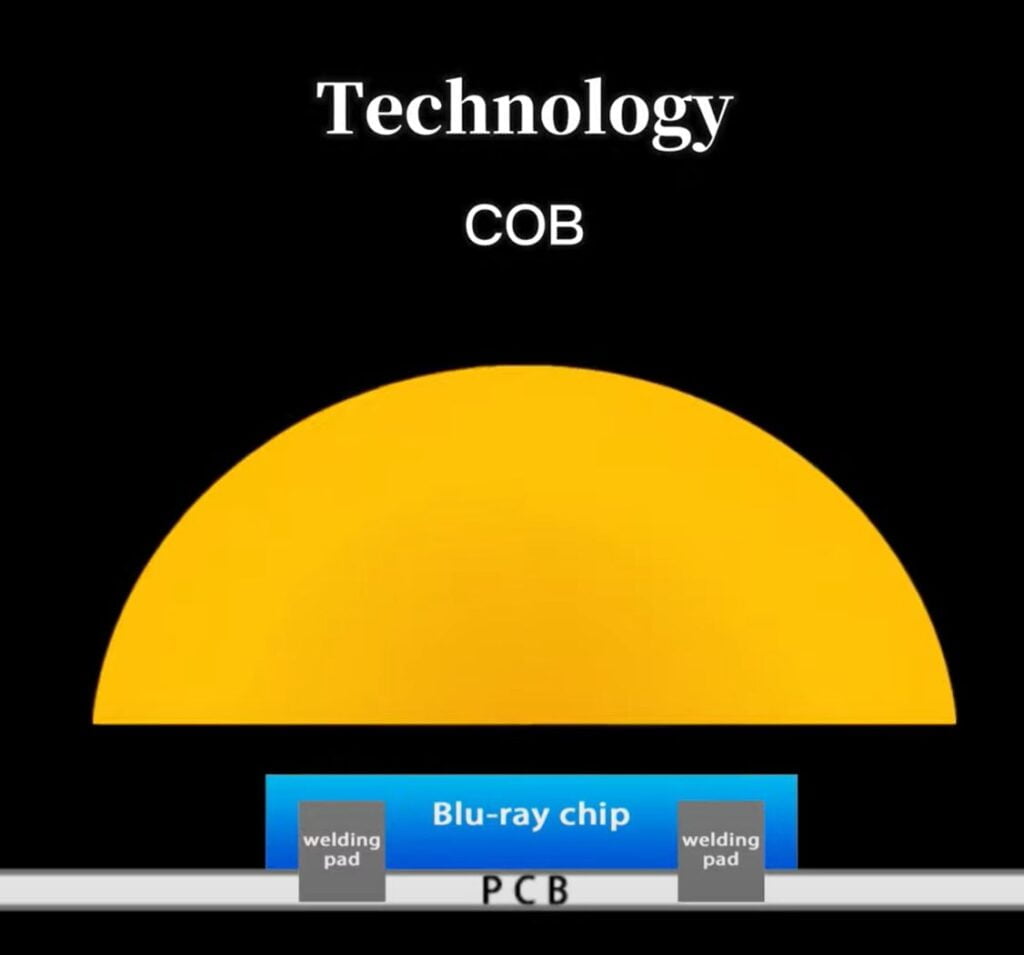
Resistant to Vulcanization
The absence of gold wires in COB LED strips, standard in traditional SMD LEDs, allows them to resist vulcanization. This is due to the construction of SMD LED lamps, where one electrode is connected to the LED bracket via gold wire while the other is connected through silver glue. Silver tended to react with sulfides to form silver sulfide, leading to darkening and reduced LED luminous flux.
Enhanced Antistatic Ability
COB LED strips’ antistatic capability outperforms traditional SMD LED strips.
Cons:
The lack of binning machines for COB LED strips means manufacturers rely on sampling to maintain color consistency. Ensuring that every COB LED strip falls within the 3-step color tolerance is challenging.
Reduced Luminous Efficiency
The efficiency of COB LED strips currently stands at around 120LM/W. If higher light efficiency is necessary, COB LED strips may not be the best choice.
Limited Power Capacity
The recommended maximum power for COB LED strips is only 15W per meter. This is due to the high number of chips per meter, making heat dissipation a challenge if the power exceeds 15W per meter, potentially reducing the lifespan of the COB LED strip.
Features of COB Flex Strips
By this point, the pros and cons of COB flex light strips should be clear. Here are some specifics on this type of light strip.
Segmentation and Connection: COB LED strips can be cut at marked points every 50mm (24V) or 25mm (12V), allowing customization to suit your requirements. While soldering is the preferred method of connecting the cut strips, COB strip connectors are also an alternative if soldering isn’t feasible.
Adjustable Brightness: COB LED strips, similar to standard SMD LED strips, are dimmable. You can use DALI, Triac, PWM, or 0-10V dimming power supply to achieve the desired brightness level with COB LED strips.
Varied Color Options: A range of color temperatures, from 2700K to 6000K, are available for white light. Other colors, such as red, green, blue, yellow, pink, etc., are also options. Moreover, tunable white, RGB, and RGBW are all available.
Mono cob led strip
CCT cob-led strip
Voltage Options:
5V(volt) cob led strip light
12V(volt) cob led strip light
24V(volt) cob led strip light
48V(volt) cob led strip light
Length Options:
5m cob-led strip
10m cob-led strip
50m cob-led strip
100m cob-led strip
Video showcasing COB LED Strip
Tunable White COB led strip
RGB COB led strip
Connector for COB LED Strips without soldering
IP Ratings
We provide a range of choices for waterproof COB LED strips.
- IP20 – Non-waterproof
- IP52 – Silicone drop protection
- IP65 – Silicone sleeve protection
- IP67 – Silicone sleeve protection We also offer other waterproofing options.
COB LED Strip Light Applications:
- Architectural Lighting
- Furniture and wine cabinet lighting
- Hotel renovation lighting
- KTV and KTV bar lighting
- Parking lighting
- Shopping mall lighting
- TV lighting
Step-by-Step Installation of COB LED Strip Light
- Prepare the surface where you intend to install the COB LED strip light by cleaning it.
- Determine the desired length of the COB LED strip light and cut it accordingly.
- Remove the backing from the 3M adhesive on the backside of the COB LED strip light.
- Apply the COB strip light to the desired location and firmly press it down.
- Connect the power supply to the COB LED strip light.
- You can solder the connections or use a COB LED strip connector for attachment if necessary.
Final Thoughts
If you are looking for a light effect without visible spots, COB LED strips are worth considering. However, if you require strict color consistency, such as 3-step Macadam color tolerance or 2-step Macadam color tolerance, or if you need high lumens and luminous efficacy, then traditional SMD LED strips are the better choice.
MyLikeLed Lighting is a professional manufacturer and factory of COB LED strip lights. We provide customized solutions and offer OEM and ODM services. Wholesalers, distributors, dealers, traders, and agents can purchase in bulk.
All our LED strips and LED neon flex products undergo rigorous testing in high-tech laboratories to ensure the highest quality. Additionally, we offer customizable options for our LED strips and neon flex. For the premium LED strips and LED neon flex, contact MyLikeLed promptly!
FAQs
COB LED strips have more densely packed LEDs compared to regular LED strips. This results in a cleaner, more even light output, while regular strips often show individual light dots.
Yes, COB LED strips are very energy efficient. They use less power while delivering high brightness, making them ideal for both home and commercial lighting projects.
You should check the strip’s brightness (lumens), color temperature, voltage, waterproof rating, and quality certifications. These factors ensure the strip matches your needs and is safe and durable.
Yes, COB LED strips can usually be cut at specific marked points. Always check the manufacturer’s guidelines to know where and how to safely cut them without damaging the strip.
Yes, COB LED strips need a compatible LED driver or power supply. Make sure the power supply matches the strip’s voltage (like 12V or 24V) and provides enough wattage to support the entire length of the strip.

Hi, I’m Xylia Xiong, a sales professional with 14 years of experience in the LED strip light industry. I specialize in providing tailored solutions, leveraging my expertise in LED products and the latest industry trends. Known for effective communication and problem-solving, I’m dedicated to helping lighting manufacturers, importers, and distributors achieve their goals.
Let’s work together to create customized solutions that exceed expectations.
Related Posts

The Best LED Strip Lights You Can Buy Right Now

Comparing WS2811 Vs WS2812B: Key Differences


